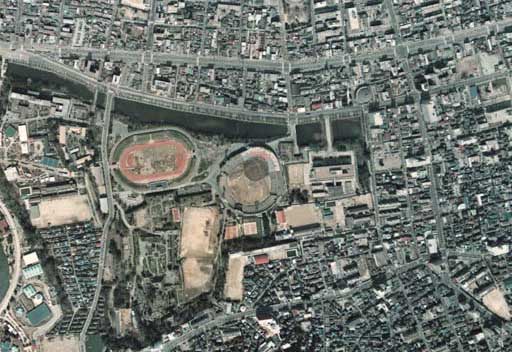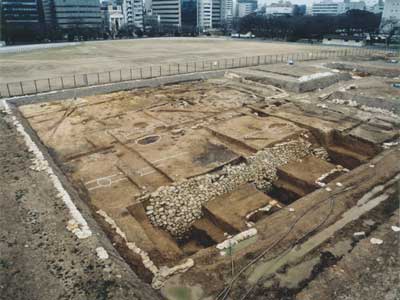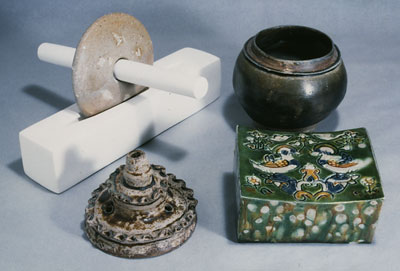Kōrokan:
A guesthouse for ancient diplomacy is revealed in its entirety

National Land Image(c)Ministry of Land, Infrastructure and Transport, Japan
(Above photo was shot in 1974)
 Southern half of the northern enclosure, encircled with a stone wall (from the south, excavation precinct for FY 2002)
Southern half of the northern enclosure, encircled with a stone wall (from the south, excavation precinct for FY 2002)
The stone wall (4 m tall) from Kōrokan’s second phase is visible in the foreground.
Parallel to the stone wall stood a row of pillars connected with a base beam. Remains of an embedded-pillar building and stone wall from the first phase (7th century, latter half) are visible in the background.

A pit (9-10th century) containing Yue ware celadon bowls collectively discarded
Bowls found in nested fashion still contained kiln furniture
separating one bowl from another, and are thought to have been
brought in the manner they were taken from the kiln.
|
|
|
 Recovered trade ceramics
Recovered trade ceramics
The grinding wheel of the tea grinder in the photo
above is a Yue ware product. The black glazed stoneware jar and brown
glazed stoneware censer lid are possibly items related to incense or
medicines. Small fragments of ceramic pillows made by mixing together
different ceramic materials, such as Tang three-colored glazed items
and Changsha kiln products, have also been recovered. The bowls and
plate in the photo at the right were imported as commodities. The
pitchers were perhaps items for trade, or may have been brought for
utilization as vessels. Items for daily use, such as mixing bowls and
lamp dishes, are also found.
Kōrokan Remains, Fukuoka City, Fukuoka Prefecture
Ōba YasutokiThe name Kōrokan, deriving from Kōroji temple which oversaw negotiations with foreign countries in ancient China, referred to guest houses for foreign visitors established at the three locations of the Heian capital, Naniwa, and Tsukushi at the start of the Heian period.
The Kōrokan of Tsukushi traces back in historical records to the Asuka period, being first seen as Tsukushikan in a Nihon shoki entry for the second year of the reign of Empress Jitō (688). It is known to have been used until its loss by fire was recorded in 1047, or for approximately 360 years, as the guest house for envoys from Tang China and Silla in Korea, serving the important function of port of entry for Japan’s foreign diplomacy, and gateway for receiving continental culture.
Discovery of Tsukushi Kōrokan
The location of Tsukushi Kōrokan was long unknown. Based on finds made near Fukuoka castle’s third keep in the prewar and postwar eras, its existence in that vicinity was inferred, but was thought to have been destroyed by repeated construction. But features were discovered in 1987 during repair work made on the outfield spectators’ seats of Heiwadai baseball stadium, and the existence of Kōrokan was confirmed. Further, excavations were begun the following year in order to reveal the entire extent of the site, and this work is still underway.
Finds replete with international flavor
From excavations conducted thus far three phases have come to light. The first phase is from the Asuka period, the second from the first half of the Nara period, and the third from the latter half of the Nara period on. From the latter half of the 7th century in the Asuka period, it is clear that large-scale groundwork accompanied by stonewall construction was undertaken. Further, changes in the buildings of Kōrokan up to the Heian period have been clarified, and it has been learned that parallel facilities were maintained, consisting of northern and southern enclosures of equal scale and with gates opening to the east. In addition, large quantities of artifacts replete with international flavor, beginning with Chinese glazed pottery, stoneware from Silla, Islamic glass, other glazed ceramics, etc., have been recovered.



